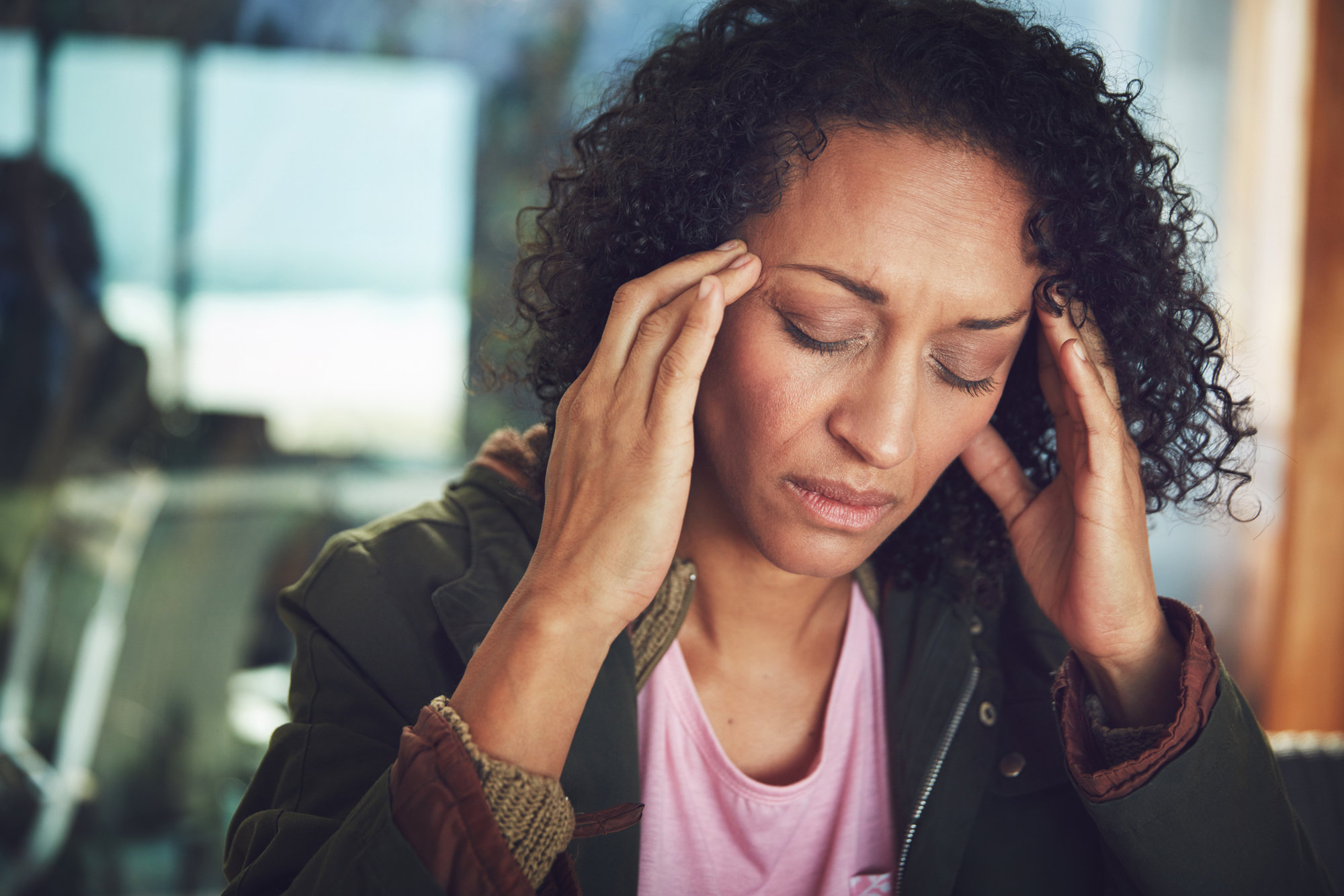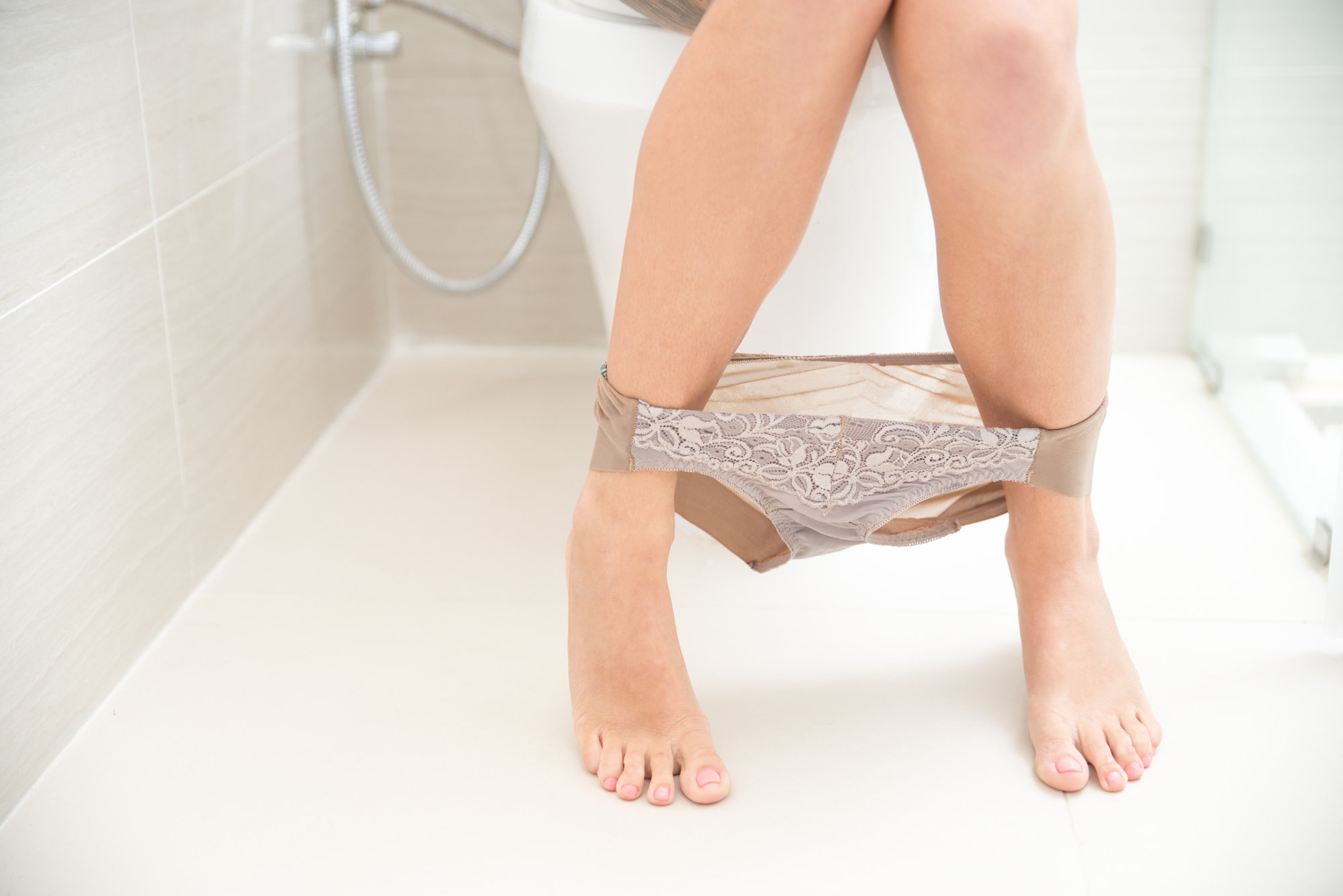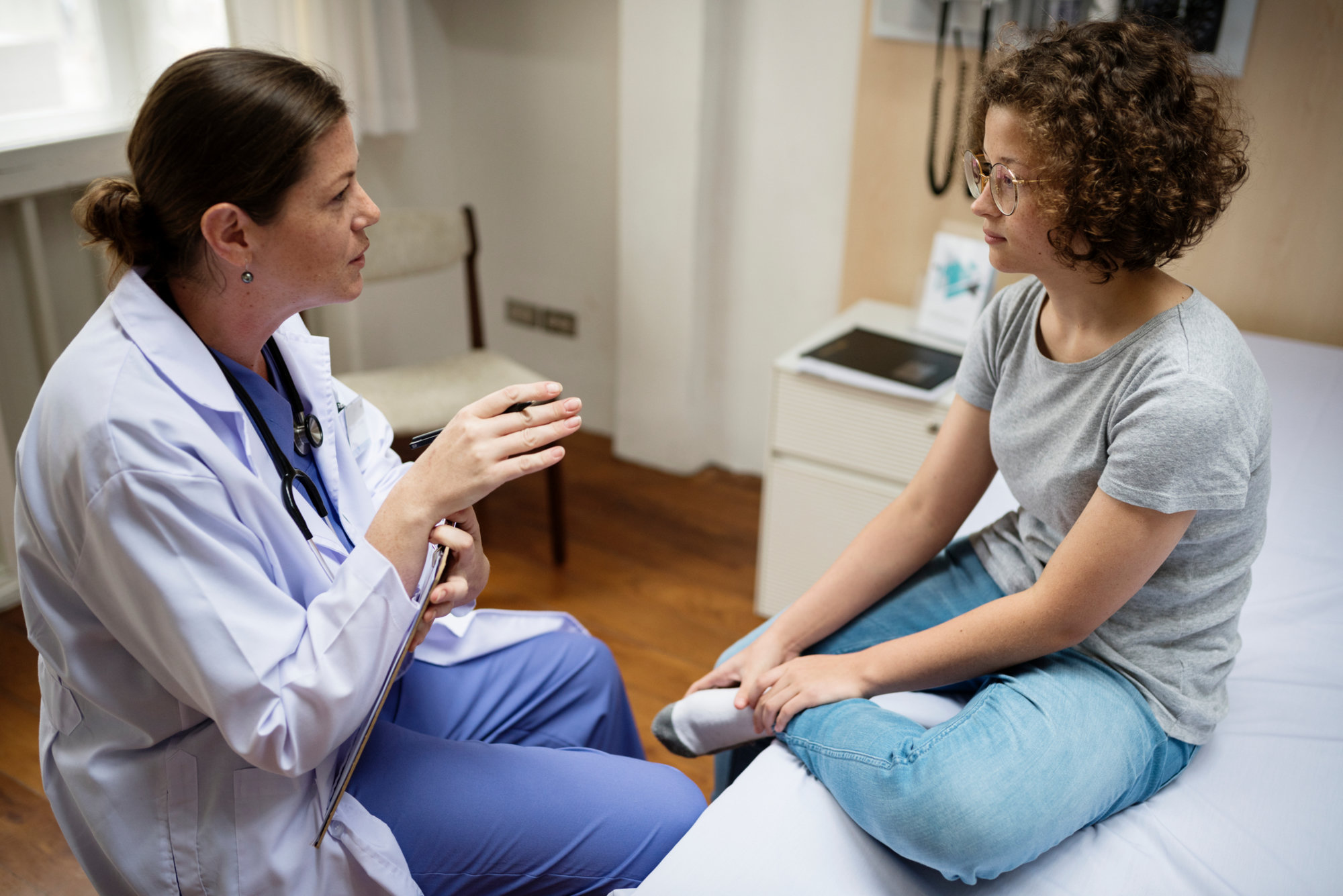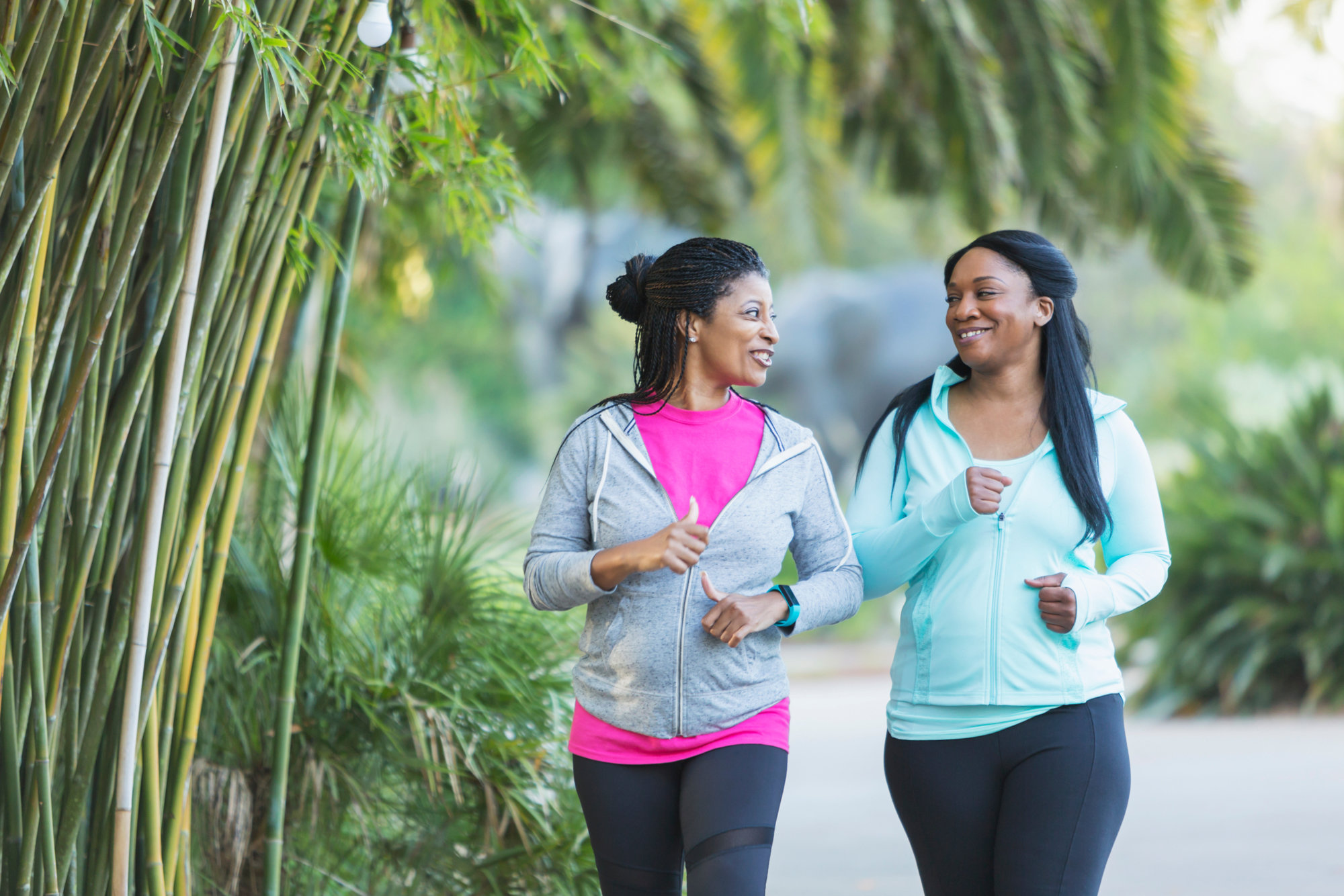I was so spooked by my friends’ experiences that I decided to do some research. Every year, thousands of women will have the same experiences my friends did. Many, unfortunately, will die. But maybe they don’t have to. Not if they know what to look for.
The biggest risk factors, says Dr. Joycelyn Speight, a radiation oncologist, are a family history of it or if the woman is carrying the BRCA gene or if she has Lynch syndrome. The last two would require genetic testing, including periodic transvaginal ultrasounds and/or the CA-125 blood test. Angelina Jolie made headlines when she opted for a double mastectomy when she discovered she carries the BRAC1 gene (her mother, Marcheline, died of ovarian cancer at age 56).
There are other smaller risk factors that could have some role in a woman developing ovarian cancer (but are not nearly as influential as BRCA or a family history), including having started her period early (for women in their 50s or 60s, this might mean at 8 or 9 years old), trouble getting pregnant, not having had any kids, and a history of the inflammatory disease endometriosis.
If you’re like me and don’t have any kind of history, we still need to be on top of our game. Look for the signs and don’t ignore them. The scary part? The symptoms tend to be vague and sneaky, symptoms that could be associated with a wide array of issues — or they could be nothing at all.
“Early diagnosis is key,” says Dr. Speight, who is based in Las Vegas. “Since we don’t have a good screening tool now, increased awareness by the patient and health-care providers is very important. Women must feel empowered to go to the doctor if they’re concerned.”
These are some of the symptoms to watch out for and are worth getting checked out by a medical professional:
Many women, myself included, have had most or all of these things at one time or another. Don’t panic. The key is whether these symptoms are not your normal state. Did they come on suddenly and haven’t gone away after a couple of weeks? Are they more noticeable and painful and insistent than you previously have experienced?
- Stay healthy. Yes, we’ve heard it a million times. Eat right, don’t drink yourself stupid, quit the cigs, work out, etc. While there is no real scientific evidence proving that doing those things will decrease your chances of getting ovarian cancer, it can help your overall immune system. Dr. Speight says healthy habits can keep your “immune surveillance system” in working order though, so it’s important to keep up a healthy lifestyle for general health benefits.
- Pay attention to your body and the signals it’s sending you. Do not put off going to a doctor if you suspect something is wrong. Only YOU truly know your body. You must be its advocate. My friends were both lucky their cancer was caught early. If you catch ovarian cancer in stages 1 or 2, says Dr. Speight, you have a 90 percent chance of hitting the five-year recovery mark (the amount of time where a person is generally considered to have “beaten” cancer — though it can still come back). Catch it in stages 3 or 4, however, when most women discover it, and your odds drop dramatically to 5 to 20 percent. We’re all busy. We don’t want to think about health issues. It’s so easy to think, “Oh, it’s just a stomach ache. I need to get Billy to his soccer game. I need to get Katie to her singing lessons. I need to finish this paper. I don’t want to ask my boss for any more time off. I’m sure it’s nothing.” But your kids need you. So do your friends and your family. And you probably want to stick around for a while. So read all of the above again, listen to your body, and do not prioritize everyone else over you.











title: “6 Everyday Aches Pains That Could Really Be Ovarian Cancer” ShowToc: true date: “2024-09-29” author: “Elizabeth Jennings”
I was so spooked by my friends’ experiences that I decided to do some research. Every year, thousands of women will have the same experiences my friends did. Many, unfortunately, will die. But maybe they don’t have to. Not if they know what to look for.
The biggest risk factors, says Dr. Joycelyn Speight, a radiation oncologist, are a family history of it or if the woman is carrying the BRCA gene or if she has Lynch syndrome. The last two would require genetic testing, including periodic transvaginal ultrasounds and/or the CA-125 blood test. Angelina Jolie made headlines when she opted for a double mastectomy when she discovered she carries the BRAC1 gene (her mother, Marcheline, died of ovarian cancer at age 56).
There are other smaller risk factors that could have some role in a woman developing ovarian cancer (but are not nearly as influential as BRCA or a family history), including having started her period early (for women in their 50s or 60s, this might mean at 8 or 9 years old), trouble getting pregnant, not having had any kids, and a history of the inflammatory disease endometriosis.
If you’re like me and don’t have any kind of history, we still need to be on top of our game. Look for the signs and don’t ignore them. The scary part? The symptoms tend to be vague and sneaky, symptoms that could be associated with a wide array of issues — or they could be nothing at all.
“Early diagnosis is key,” says Dr. Speight, who is based in Las Vegas. “Since we don’t have a good screening tool now, increased awareness by the patient and health-care providers is very important. Women must feel empowered to go to the doctor if they’re concerned.”
These are some of the symptoms to watch out for and are worth getting checked out by a medical professional:
Many women, myself included, have had most or all of these things at one time or another. Don’t panic. The key is whether these symptoms are not your normal state. Did they come on suddenly and haven’t gone away after a couple of weeks? Are they more noticeable and painful and insistent than you previously have experienced?
- Stay healthy. Yes, we’ve heard it a million times. Eat right, don’t drink yourself stupid, quit the cigs, work out, etc. While there is no real scientific evidence proving that doing those things will decrease your chances of getting ovarian cancer, it can help your overall immune system. Dr. Speight says healthy habits can keep your “immune surveillance system” in working order though, so it’s important to keep up a healthy lifestyle for general health benefits.
- Pay attention to your body and the signals it’s sending you. Do not put off going to a doctor if you suspect something is wrong. Only YOU truly know your body. You must be its advocate. My friends were both lucky their cancer was caught early. If you catch ovarian cancer in stages 1 or 2, says Dr. Speight, you have a 90 percent chance of hitting the five-year recovery mark (the amount of time where a person is generally considered to have “beaten” cancer — though it can still come back). Catch it in stages 3 or 4, however, when most women discover it, and your odds drop dramatically to 5 to 20 percent. We’re all busy. We don’t want to think about health issues. It’s so easy to think, “Oh, it’s just a stomach ache. I need to get Billy to his soccer game. I need to get Katie to her singing lessons. I need to finish this paper. I don’t want to ask my boss for any more time off. I’m sure it’s nothing.” But your kids need you. So do your friends and your family. And you probably want to stick around for a while. So read all of the above again, listen to your body, and do not prioritize everyone else over you.











title: “6 Everyday Aches Pains That Could Really Be Ovarian Cancer” ShowToc: true date: “2024-09-18” author: “Fay Humphrey”
I was so spooked by my friends’ experiences that I decided to do some research. Every year, thousands of women will have the same experiences my friends did. Many, unfortunately, will die. But maybe they don’t have to. Not if they know what to look for.
The biggest risk factors, says Dr. Joycelyn Speight, a radiation oncologist, are a family history of it or if the woman is carrying the BRCA gene or if she has Lynch syndrome. The last two would require genetic testing, including periodic transvaginal ultrasounds and/or the CA-125 blood test. Angelina Jolie made headlines when she opted for a double mastectomy when she discovered she carries the BRAC1 gene (her mother, Marcheline, died of ovarian cancer at age 56).
There are other smaller risk factors that could have some role in a woman developing ovarian cancer (but are not nearly as influential as BRCA or a family history), including having started her period early (for women in their 50s or 60s, this might mean at 8 or 9 years old), trouble getting pregnant, not having had any kids, and a history of the inflammatory disease endometriosis.
If you’re like me and don’t have any kind of history, we still need to be on top of our game. Look for the signs and don’t ignore them. The scary part? The symptoms tend to be vague and sneaky, symptoms that could be associated with a wide array of issues — or they could be nothing at all.
“Early diagnosis is key,” says Dr. Speight, who is based in Las Vegas. “Since we don’t have a good screening tool now, increased awareness by the patient and health-care providers is very important. Women must feel empowered to go to the doctor if they’re concerned.”
These are some of the symptoms to watch out for and are worth getting checked out by a medical professional:
Many women, myself included, have had most or all of these things at one time or another. Don’t panic. The key is whether these symptoms are not your normal state. Did they come on suddenly and haven’t gone away after a couple of weeks? Are they more noticeable and painful and insistent than you previously have experienced?
- Stay healthy. Yes, we’ve heard it a million times. Eat right, don’t drink yourself stupid, quit the cigs, work out, etc. While there is no real scientific evidence proving that doing those things will decrease your chances of getting ovarian cancer, it can help your overall immune system. Dr. Speight says healthy habits can keep your “immune surveillance system” in working order though, so it’s important to keep up a healthy lifestyle for general health benefits.
- Pay attention to your body and the signals it’s sending you. Do not put off going to a doctor if you suspect something is wrong. Only YOU truly know your body. You must be its advocate. My friends were both lucky their cancer was caught early. If you catch ovarian cancer in stages 1 or 2, says Dr. Speight, you have a 90 percent chance of hitting the five-year recovery mark (the amount of time where a person is generally considered to have “beaten” cancer — though it can still come back). Catch it in stages 3 or 4, however, when most women discover it, and your odds drop dramatically to 5 to 20 percent. We’re all busy. We don’t want to think about health issues. It’s so easy to think, “Oh, it’s just a stomach ache. I need to get Billy to his soccer game. I need to get Katie to her singing lessons. I need to finish this paper. I don’t want to ask my boss for any more time off. I’m sure it’s nothing.” But your kids need you. So do your friends and your family. And you probably want to stick around for a while. So read all of the above again, listen to your body, and do not prioritize everyone else over you.











title: “6 Everyday Aches Pains That Could Really Be Ovarian Cancer” ShowToc: true date: “2024-10-05” author: “Brett Harrison”
I was so spooked by my friends’ experiences that I decided to do some research. Every year, thousands of women will have the same experiences my friends did. Many, unfortunately, will die. But maybe they don’t have to. Not if they know what to look for.
The biggest risk factors, says Dr. Joycelyn Speight, a radiation oncologist, are a family history of it or if the woman is carrying the BRCA gene or if she has Lynch syndrome. The last two would require genetic testing, including periodic transvaginal ultrasounds and/or the CA-125 blood test. Angelina Jolie made headlines when she opted for a double mastectomy when she discovered she carries the BRAC1 gene (her mother, Marcheline, died of ovarian cancer at age 56).
There are other smaller risk factors that could have some role in a woman developing ovarian cancer (but are not nearly as influential as BRCA or a family history), including having started her period early (for women in their 50s or 60s, this might mean at 8 or 9 years old), trouble getting pregnant, not having had any kids, and a history of the inflammatory disease endometriosis.
If you’re like me and don’t have any kind of history, we still need to be on top of our game. Look for the signs and don’t ignore them. The scary part? The symptoms tend to be vague and sneaky, symptoms that could be associated with a wide array of issues — or they could be nothing at all.
“Early diagnosis is key,” says Dr. Speight, who is based in Las Vegas. “Since we don’t have a good screening tool now, increased awareness by the patient and health-care providers is very important. Women must feel empowered to go to the doctor if they’re concerned.”
These are some of the symptoms to watch out for and are worth getting checked out by a medical professional:
Many women, myself included, have had most or all of these things at one time or another. Don’t panic. The key is whether these symptoms are not your normal state. Did they come on suddenly and haven’t gone away after a couple of weeks? Are they more noticeable and painful and insistent than you previously have experienced?
- Stay healthy. Yes, we’ve heard it a million times. Eat right, don’t drink yourself stupid, quit the cigs, work out, etc. While there is no real scientific evidence proving that doing those things will decrease your chances of getting ovarian cancer, it can help your overall immune system. Dr. Speight says healthy habits can keep your “immune surveillance system” in working order though, so it’s important to keep up a healthy lifestyle for general health benefits.
- Pay attention to your body and the signals it’s sending you. Do not put off going to a doctor if you suspect something is wrong. Only YOU truly know your body. You must be its advocate. My friends were both lucky their cancer was caught early. If you catch ovarian cancer in stages 1 or 2, says Dr. Speight, you have a 90 percent chance of hitting the five-year recovery mark (the amount of time where a person is generally considered to have “beaten” cancer — though it can still come back). Catch it in stages 3 or 4, however, when most women discover it, and your odds drop dramatically to 5 to 20 percent. We’re all busy. We don’t want to think about health issues. It’s so easy to think, “Oh, it’s just a stomach ache. I need to get Billy to his soccer game. I need to get Katie to her singing lessons. I need to finish this paper. I don’t want to ask my boss for any more time off. I’m sure it’s nothing.” But your kids need you. So do your friends and your family. And you probably want to stick around for a while. So read all of the above again, listen to your body, and do not prioritize everyone else over you.











title: “6 Everyday Aches Pains That Could Really Be Ovarian Cancer” ShowToc: true date: “2024-09-17” author: “Catherine Gallagher”
I was so spooked by my friends’ experiences that I decided to do some research. Every year, thousands of women will have the same experiences my friends did. Many, unfortunately, will die. But maybe they don’t have to. Not if they know what to look for.
The biggest risk factors, says Dr. Joycelyn Speight, a radiation oncologist, are a family history of it or if the woman is carrying the BRCA gene or if she has Lynch syndrome. The last two would require genetic testing, including periodic transvaginal ultrasounds and/or the CA-125 blood test. Angelina Jolie made headlines when she opted for a double mastectomy when she discovered she carries the BRAC1 gene (her mother, Marcheline, died of ovarian cancer at age 56).
There are other smaller risk factors that could have some role in a woman developing ovarian cancer (but are not nearly as influential as BRCA or a family history), including having started her period early (for women in their 50s or 60s, this might mean at 8 or 9 years old), trouble getting pregnant, not having had any kids, and a history of the inflammatory disease endometriosis.
If you’re like me and don’t have any kind of history, we still need to be on top of our game. Look for the signs and don’t ignore them. The scary part? The symptoms tend to be vague and sneaky, symptoms that could be associated with a wide array of issues — or they could be nothing at all.
“Early diagnosis is key,” says Dr. Speight, who is based in Las Vegas. “Since we don’t have a good screening tool now, increased awareness by the patient and health-care providers is very important. Women must feel empowered to go to the doctor if they’re concerned.”
These are some of the symptoms to watch out for and are worth getting checked out by a medical professional:
Many women, myself included, have had most or all of these things at one time or another. Don’t panic. The key is whether these symptoms are not your normal state. Did they come on suddenly and haven’t gone away after a couple of weeks? Are they more noticeable and painful and insistent than you previously have experienced?
- Stay healthy. Yes, we’ve heard it a million times. Eat right, don’t drink yourself stupid, quit the cigs, work out, etc. While there is no real scientific evidence proving that doing those things will decrease your chances of getting ovarian cancer, it can help your overall immune system. Dr. Speight says healthy habits can keep your “immune surveillance system” in working order though, so it’s important to keep up a healthy lifestyle for general health benefits.
- Pay attention to your body and the signals it’s sending you. Do not put off going to a doctor if you suspect something is wrong. Only YOU truly know your body. You must be its advocate. My friends were both lucky their cancer was caught early. If you catch ovarian cancer in stages 1 or 2, says Dr. Speight, you have a 90 percent chance of hitting the five-year recovery mark (the amount of time where a person is generally considered to have “beaten” cancer — though it can still come back). Catch it in stages 3 or 4, however, when most women discover it, and your odds drop dramatically to 5 to 20 percent. We’re all busy. We don’t want to think about health issues. It’s so easy to think, “Oh, it’s just a stomach ache. I need to get Billy to his soccer game. I need to get Katie to her singing lessons. I need to finish this paper. I don’t want to ask my boss for any more time off. I’m sure it’s nothing.” But your kids need you. So do your friends and your family. And you probably want to stick around for a while. So read all of the above again, listen to your body, and do not prioritize everyone else over you.











title: “6 Everyday Aches Pains That Could Really Be Ovarian Cancer” ShowToc: true date: “2024-09-16” author: “Larry Retchless”
I was so spooked by my friends’ experiences that I decided to do some research. Every year, thousands of women will have the same experiences my friends did. Many, unfortunately, will die. But maybe they don’t have to. Not if they know what to look for.
The biggest risk factors, says Dr. Joycelyn Speight, a radiation oncologist, are a family history of it or if the woman is carrying the BRCA gene or if she has Lynch syndrome. The last two would require genetic testing, including periodic transvaginal ultrasounds and/or the CA-125 blood test. Angelina Jolie made headlines when she opted for a double mastectomy when she discovered she carries the BRAC1 gene (her mother, Marcheline, died of ovarian cancer at age 56).
There are other smaller risk factors that could have some role in a woman developing ovarian cancer (but are not nearly as influential as BRCA or a family history), including having started her period early (for women in their 50s or 60s, this might mean at 8 or 9 years old), trouble getting pregnant, not having had any kids, and a history of the inflammatory disease endometriosis.
If you’re like me and don’t have any kind of history, we still need to be on top of our game. Look for the signs and don’t ignore them. The scary part? The symptoms tend to be vague and sneaky, symptoms that could be associated with a wide array of issues — or they could be nothing at all.
“Early diagnosis is key,” says Dr. Speight, who is based in Las Vegas. “Since we don’t have a good screening tool now, increased awareness by the patient and health-care providers is very important. Women must feel empowered to go to the doctor if they’re concerned.”
These are some of the symptoms to watch out for and are worth getting checked out by a medical professional:
Many women, myself included, have had most or all of these things at one time or another. Don’t panic. The key is whether these symptoms are not your normal state. Did they come on suddenly and haven’t gone away after a couple of weeks? Are they more noticeable and painful and insistent than you previously have experienced?
- Stay healthy. Yes, we’ve heard it a million times. Eat right, don’t drink yourself stupid, quit the cigs, work out, etc. While there is no real scientific evidence proving that doing those things will decrease your chances of getting ovarian cancer, it can help your overall immune system. Dr. Speight says healthy habits can keep your “immune surveillance system” in working order though, so it’s important to keep up a healthy lifestyle for general health benefits.
- Pay attention to your body and the signals it’s sending you. Do not put off going to a doctor if you suspect something is wrong. Only YOU truly know your body. You must be its advocate. My friends were both lucky their cancer was caught early. If you catch ovarian cancer in stages 1 or 2, says Dr. Speight, you have a 90 percent chance of hitting the five-year recovery mark (the amount of time where a person is generally considered to have “beaten” cancer — though it can still come back). Catch it in stages 3 or 4, however, when most women discover it, and your odds drop dramatically to 5 to 20 percent. We’re all busy. We don’t want to think about health issues. It’s so easy to think, “Oh, it’s just a stomach ache. I need to get Billy to his soccer game. I need to get Katie to her singing lessons. I need to finish this paper. I don’t want to ask my boss for any more time off. I’m sure it’s nothing.” But your kids need you. So do your friends and your family. And you probably want to stick around for a while. So read all of the above again, listen to your body, and do not prioritize everyone else over you.











title: “6 Everyday Aches Pains That Could Really Be Ovarian Cancer” ShowToc: true date: “2024-10-22” author: “William Yucha”
I was so spooked by my friends’ experiences that I decided to do some research. Every year, thousands of women will have the same experiences my friends did. Many, unfortunately, will die. But maybe they don’t have to. Not if they know what to look for.
The biggest risk factors, says Dr. Joycelyn Speight, a radiation oncologist, are a family history of it or if the woman is carrying the BRCA gene or if she has Lynch syndrome. The last two would require genetic testing, including periodic transvaginal ultrasounds and/or the CA-125 blood test. Angelina Jolie made headlines when she opted for a double mastectomy when she discovered she carries the BRAC1 gene (her mother, Marcheline, died of ovarian cancer at age 56).
There are other smaller risk factors that could have some role in a woman developing ovarian cancer (but are not nearly as influential as BRCA or a family history), including having started her period early (for women in their 50s or 60s, this might mean at 8 or 9 years old), trouble getting pregnant, not having had any kids, and a history of the inflammatory disease endometriosis.
If you’re like me and don’t have any kind of history, we still need to be on top of our game. Look for the signs and don’t ignore them. The scary part? The symptoms tend to be vague and sneaky, symptoms that could be associated with a wide array of issues — or they could be nothing at all.
“Early diagnosis is key,” says Dr. Speight, who is based in Las Vegas. “Since we don’t have a good screening tool now, increased awareness by the patient and health-care providers is very important. Women must feel empowered to go to the doctor if they’re concerned.”
These are some of the symptoms to watch out for and are worth getting checked out by a medical professional:
Many women, myself included, have had most or all of these things at one time or another. Don’t panic. The key is whether these symptoms are not your normal state. Did they come on suddenly and haven’t gone away after a couple of weeks? Are they more noticeable and painful and insistent than you previously have experienced?
- Stay healthy. Yes, we’ve heard it a million times. Eat right, don’t drink yourself stupid, quit the cigs, work out, etc. While there is no real scientific evidence proving that doing those things will decrease your chances of getting ovarian cancer, it can help your overall immune system. Dr. Speight says healthy habits can keep your “immune surveillance system” in working order though, so it’s important to keep up a healthy lifestyle for general health benefits.
- Pay attention to your body and the signals it’s sending you. Do not put off going to a doctor if you suspect something is wrong. Only YOU truly know your body. You must be its advocate. My friends were both lucky their cancer was caught early. If you catch ovarian cancer in stages 1 or 2, says Dr. Speight, you have a 90 percent chance of hitting the five-year recovery mark (the amount of time where a person is generally considered to have “beaten” cancer — though it can still come back). Catch it in stages 3 or 4, however, when most women discover it, and your odds drop dramatically to 5 to 20 percent. We’re all busy. We don’t want to think about health issues. It’s so easy to think, “Oh, it’s just a stomach ache. I need to get Billy to his soccer game. I need to get Katie to her singing lessons. I need to finish this paper. I don’t want to ask my boss for any more time off. I’m sure it’s nothing.” But your kids need you. So do your friends and your family. And you probably want to stick around for a while. So read all of the above again, listen to your body, and do not prioritize everyone else over you.










